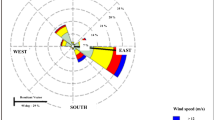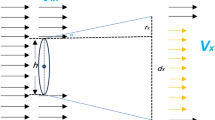Abstract
Most wind turbines within wind farms are set up to face a pre-determined wind direction. However, wind directions are intermittent in nature, leading to less electricity production capacity. This paper proposes an algorithm to solve the wind farm layout optimization problem considering multi-angular (MA) wind direction with the aim of maximizing the total power generated on wind farms and minimizing the cost of installation. A twostage genetic algorithm (GA) equipped with complementary sampling and uniform crossover is used to evolve a MA layout that will yield optimal output regardless of the wind direction. In the first stage, the optimal wind turbine layouts for 8 different major wind directions were determined while the second stage allows each of the previously determined layouts to compete and inter-breed so as to evolve an optimal MA wind farm layout. The proposed MA wind farm layout is thereafter compared to other layouts whose turbines have focused site specific wind turbine orientation. The results reveal that the proposed wind farm layout improves wind power production capacity with minimum cost of installation compared to the layouts with site specific wind turbine layouts. This paper will find application at the planning stage of wind farm.
Similar content being viewed by others
References
Ayodele T R, Ogunjuyigbe A S O. Increasing household solar energy penetration through load partitioning based on quality of life: the case study of Nigeria. Sustainable Cities and Society, 2015, 18: 21–31
Ayodele T R, Jimoh A A, Munda J L, Agee J T. Viability and economic analysis of wind energy resource for power generation in Johannesburg, South Africa. International Journal of Sustainable Energy, 2014, 33(2): 284–303
Ayodele T R, Ogunjuyigbe A S O. Wind energy potential of vesleskarvet and the feasibility of meeting the South African’s SANAE IV energy demand. Renewable & Sustainable Energy Reviews, 2016, 56: 226–234
Bansal R C, Bhatti T S, Kothari D P. On some of the design aspects of wind energy conversion systems. Energy Conversion and Management, 2002, 43(16): 2175–2187
Patel M. Wind and Power Solar Systems. Boca Raton: CRC Press, 1999
Ammara I, Leclerc C, Masson C. A viscous three-dimensional differential/actuator-disk method for the aerodynamic analysis of wind farms. Solar Energy Engineering, 2002, 124(4): 345–356
Ituarte-Villareal C M, Espiritu J F. Optimization of wind turbine placement using a viral based optimization algorithm. Procedia Computer Science, 2011, 6: 469–474
Wang J, Li X, Zhang X. Genetic optimal micrositing of wind farms by equilateral-triangle mesh. In: Wind Turbines. London: InTech, 2011
Marmidis G, Lazarou S, Pyrgioti E. Optimal placement of wind turbines in a wind park using monte carlo simulation. Renewable Energy, 2008, 33(7): 1455–1460
Tabassum M, Mathew K. A genetic algorithm analysis towards optimization solutions. International Journal of Digital Information and Wireless Communications, 2014, 4(1): 124–142
Mosetti G, Poloni C, Diviacco B. Optimization of wind turbine positioning in large wind farms by means of a genetic algorithm. Journal of Wind Engineering and Industrial Aerodynamics, 1994, 51 (1): 105–116
Grady S A, Hussaini M Y, Abdullah M M. Placement of wind turbines using genetic algorithms. Renewable Energy, 2005, 30(2): 259–270
Mittal P, Kulkarni K, Mitra K. A novel hybrid optimization methodology to optimize the total number and placement of wind turbines. Renewable Energy, 2016, 86: 133–147
Serrano González J, Burgos Payán M, Santos J M R, González-Longatt F. A review and recent developments in the optimal windturbine micro-siting problem. Renewable & Sustainable Energy Reviews, 2014, 30(2): 133–144
Mortensen N G. The wind atlas analysis and application program. Mutation Research/environmental Mutagenesis & Related Subjects, 1996, 2(3): 348–349
Herbert-Acero J F, Probst O, Réthoré P E, Larsen G C, Castillo-Villar K K. A review of methodological approaches for the design and optimization of wind farms. Energies, 2014, 7(11): 6930–7016
Shakoor R, Hassan M Y, Raheem A, Wu Y K. Wake effect modeling: a review of wind farm layout optimization using Jensen’s model. Renewable & Sustainable Energy Reviews, 2016, 58: 1048–1059
Katic I, Hojstrup J, Jensen N O. A simple model for cluster efficiency. In: European Wind Energy Conference (EWEC’86), Rome, 1986, 407–410
González-Longatt F, Wall P P, Terzija V. Wake effect in wind farm performance: steady-state and dynamic behavior. Renewable Energy, 2012, 39(1): 329–338
Ogunjuyigbe A S O, Ayodele T R, Bamgboje O D, Jimoh A A. Optimal placement of wind turbines within a wind farm using genetic algorithm. In: the International Renewable Energy Congress, Hammamet, Tunisia, 2016, 1–6
Emami A, Noghreh P. New approach on optimization in placement of wind turbines within wind farm by genetic algorithm. Renewable Energy, 2010, 35(7): 1559–1564
Marmidis G, Lazarou S, Pyrgioti E. Optimal placement of wind turbines in a wind park using monte carlo simulation. Renewable Energy, 2008, 33(7): 1455–1460
Haupt R L, Haupt S E. Practical Genetic Algorithm, 2nd ed. New Jersey: John Wiley & Sons, Inc., 2004
Acknowledgements
The authors want to thank the University of Ibadan for the conducive environment during the course of the research.
Author information
Authors and Affiliations
Corresponding author
Rights and permissions
About this article
Cite this article
Ogunjuyigbe, A.S.O., Ayodele, T.R. & Bamgboje, O.D. Optimal placement of wind turbines within a wind farm considering multi-directional wind speed using two-stage genetic algorithm. Front. Energy 15, 240–255 (2021). https://doi.org/10.1007/s11708-018-0514-x
Received:
Accepted:
Published:
Issue Date:
DOI: https://doi.org/10.1007/s11708-018-0514-x




